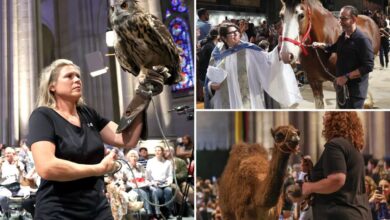Jane Goodall’s work is helping upend our understanding of human nature

Jane Goodall died Wednesday. As she was universally regarded as the greatest living expert on chimpanzees, her passing is a momentous event.
It’s one that comes at a time of upheaval in the field she helped create.
Goodall’s career commenced when she traveled to Tanzania in 1960 and began studying chimps in the wild.
Some of her revelations, like the discovery chimps can make simple tools, showed their commonality with us.
Others, like the finding they sometimes consume each other’s babies, displayed the gulf between our species.
Her admirers focused on the kinship, and an oft-repeated claim buttressed the belief they’re like us: We share 98.6% of our genes with chimpanzees.
Yet a burgeoning conflict over the extent of our likeness has been hastened by a study published in April.
Produced by a team of the world’s top geneticists, it revealed we’re only 86.5% genetically akin to chimps and just 73% the same as orangutans.
Other recent research has been pointing up the locations where our DNA is shifting. Most often the changes are materializing in the genes for our brains.
Since this is the code that determines our nature, that’s critically important.
Goodall’s view of the primate order was complex. So she may not have been so surprised by the discovery our genome has diverged so greatly.
Based on her years of observations, Goodall freely acknowledged “altruistic feelings” were “probably rare” among chimpanzees.
That’s ironic as those who followed her in the path of primate field research have been inclined to dispute a similar conclusion put forward by the neuroscientists who study the parts of our brain that give us the capacity for empathy — regions like the amygdala and the anterior cingulate gyrus.
They have shown these regions function differently in our brains than the corresponding areas in chimps.
That may explain the results of a peculiar study.
A group of primate researchers devised a contraption with two ropes. By pulling on one, a chimp could obtain a meal for himself. The other provided one to himself and another chimp.
The scientists learned the chance to help another chimp had no effect on their behavior. The chimps pulled the ropes randomly.
By contrast, 3-year-old children take pleasure in sharing food with one another, and they do so even when they’re hungry.
Recent discoveries have shown many other parts of our brain are organized differently.
Our prefrontal cortex, which assists in planning and civilized action, is six times larger than theirs.
Neuroscientists have also revealed a key type of brain cell that helps with social behavior and intuitive judgment — a von Economo neuron — is much more likely to be found in humans, elephants and dolphins than in apes.
In fact, a number of neuroscientists now argue that in some important respects our brains may be more like those of dolphins than primates.
And it isn’t only our brains that are unalike. Ordinary metrics show our wide divergence from our primate ancestors.
All primates sleep a lot: from 10.5 to 19 hours each day. But humans typically sleep much less: about seven hours.
Similarly, all primates lack endurance, though they possess explosive strength. Yet, like horses and camels, we have exceptional endurance, but we’re without that super-strength.
Humans fail even to meet one of the supposed requirements for inclusion in the primate order as we don’t possess the prehensile feet that help define it.
We are without those feet, essentially a second set of hands, because we don’t climb trees.
Apes and monkeys, however, spend time in the treetops, as their diet depends upon leaves, nuts and fruit.
Goodall made the discovery that chimps hunt, and they do occasionally eat meat. Yet this provides them with only 1% to 3% of their caloric consumption.
By contrast, throughout our prehistory, we relied upon hunting as the principal means by which to feed ourselves.
It’s easy to forget how extraordinary this achievement was.
Terrestrial carnivores possess a set design: big canine teeth, four legs for sprinter speed and powerful chest muscles for pinning prey.
We have none of those. Yet prehistoric Homo sapiens even hunted woolly mammoths. These pachyderms were 50% larger than the largest surviving elephants.
Poachers who hunt elephants use giant rifles called elephant guns, or they poison them and then shoot at them with machine guns. Firing ordinary handguns or rifles can lead to stampeding and the hunter’s death.
So how was primitive man able to slay huge, highly intelligent game animals with just spears and pikes?
The answer is simple. We developed language, and we became a highly cooperative, obedient animal skilled at working together. In this way, we attacked as a group, driving the mammoths into pits.
That might explain some of the similarities in our brains and those of dolphins.
After all, this fits with the theory of evolution since it says animals rapidly evolve to meet the requirements for their survival.
As dolphins are also tame, cooperative creatures who make use of language when they hunt, it makes sense they would have some similar patterns of thought and behavior.
Dolphins can be classified as pack animals while the animals with our patterns of sleep and endurance are herd animals.
Those facts prompt a fascinating question: Did the distinctive pressures of human evolution push us towards taking on some of the attributes of herd and pack animals?
If so, that would offer important clues about crucial patterns of human behavior like those seen in war and lovemaking.
Primatologists have long argued wars reflect innate primate impulses towards aggression.
That presents a puzzle though. No democracies in which women have the vote have ever gone to war with one another, and few such neighboring states even bother guarding the borders they share.
Further, the most warlike of all animals is the most obedient: the ant. And the creatures we employ in our wars — horses, camels, dogs, elephants, dolphins and pigeons — are tame.
This suggests another explanation. Perhaps wars are principally caused not by our aggressive impulses but by how docile and biddable we are. This allows authoritarian leaders to manipulate young men into taking up arms.
Primatologists have also indicated humans might function well in polyamorous relationships. That’s because chimps and bonobos are extremely promiscuous, and they never know their paternity.
Yet genetic testing has revealed how rare human cuckoldry is: No mammal species ever studied shows lower rates of false paternity.
This makes evolutionary sense as humans take an unusually long time to nurture and raise. Joint, faithful child-rearing is thus of great evolutionary value, and our lovemaking may be meant as much for bolstering pair-bonding as for procreation.
Chimps are among the most dangerous of all animals.
One study of chimp researchers’ work in Africa found that through 426 years of observations they had uncovered 152 chimp killings, and 58 of those they witnessed with their own eyes.
In other words, a chimp researcher becomes aware of a chimp slaying another chimp more than once for every three years he’s in the field, and he’ll directly observe a chimp killing another chimp roughly once every eight years.
Even so, Goodall managed to acquaint herself with the chimps she studied so well that she actually fed some of them out of her own hands.
And when she had a newborn son, she continued to go out among the chimps, placing her child in a steel cage to protect him from the very real possibility the chimps might kill and eat him.
Simply put, Goodall was not only curious, determined and patient but uncommonly brave.
Altogether, we should cherish her legacy, even if a growing body of evidence — much of which she herself provided — makes us acutely aware of our profound differences from the order of animals from which we descend.
Jonathan Leaf’s new book, “The Primate Myth: Why the Latest Science Leads Us to a New Theory of Human Nature,” will be released Oct. 21 by Bombardier Books/Simon & Schuster.
Credit to Nypost AND Peoples




